Cyrtognatha
Dimitar Dimitrov and Gustavo Hormiga


This tree diagram shows the relationships between several groups of organisms.
The root of the current tree connects the organisms featured in this tree to their containing group and the rest of the Tree of Life. The basal branching point in the tree represents the ancestor of the other groups in the tree. This ancestor diversified over time into several descendent subgroups, which are represented as internal nodes and terminal taxa to the right.

You can click on the root to travel down the Tree of Life all the way to the root of all Life, and you can click on the names of descendent subgroups to travel up the Tree of Life all the way to individual species.
For more information on ToL tree formatting, please see Interpreting the Tree or Classification. To learn more about phylogenetic trees, please visit our Phylogenetic Biology pages.
close boxIntroduction
Cyrtognatha species live in cloud forests in the Neotropical region, including some of the Caribbean Islands (for distribution map see Dimitrov and Hormiga, 2009). Most of the species are bright green or yellowish colored, with numerous reflective guanine spots on the abdomen that make the animals look shiny. In a recent taxonomic revision Dimtirov and Hormiga (2009) circumscribed the genus to include 21 species, more than half of them new to science. Given that most of the species are known from just a few museum specimens and that the genus is distributed in some of the most biologically diverse areas in the world, it is predicted that many species of Cyrtognatha remain to be discovered.
Characteristics
Cyrtognatha species can be easily distinguished from other tetragnathids: adults of both sexes and juveniles always have a line of modified macrosetae on the retrolateral surface of the posterior lateral spinnerets. This character is particularly relevant when dealing with inmatures as it allows correct generic determination. Another diagnostic feature of Cyrtognatha, found also in juveniles, is the presence of in a single row of two types of trichobothria on the fourth leg femur: short and smooth trichobothria are alternated with longer feathered ones. In addition, unlike other tetragnathines, males of Cyrtognatha have an enlarged and very complex embolus which in most species also has a well developed metine embolic apophysis.

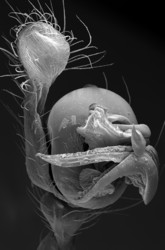
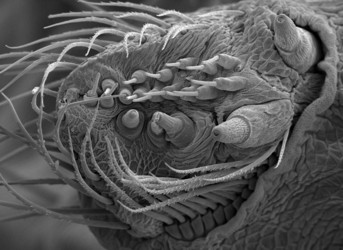
Left: Male pedipalp of Cyrtognatha quichua. Right: Posterior lateral spinnerets of Cyrtognatha pachygnathoides. Note the line of modified macrosetae. Images © 2007 Dimitar Dimitrov
Like other tetragnathines, Cyrtognatha females have haplogyne genitalia but the spermathecae are vestigial and the sperm storage function is undertaken by a specialized unpaired organ known as the "posterior sac" (Dimitrov et al., 2007). Nothing is known about the courtship behavior and copulation in Cyrtognatha.

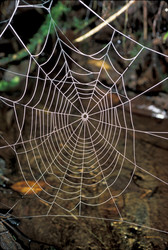
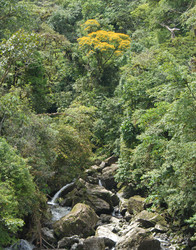

Left: Cyrtognatha quichua web (Ecuador). Center: Cyrtognatha habitat (Panama). Right: Cyrtognatha habitat (Panama). Images © Gustavo Hormiga
Cyrtognatha species build horizontal, in some cases vertical, orb webs with relatively few radii and spiral turns and an open hub. The spider usually stays at the hub, but when disturbed it runs from the web and hides in the surrounding vegetation.
Discussion of Phylogenetic Relationships
The first phylogenetic study to include a representative of Cyrtognatha was that of Álvarez-Padilla (2007). At that time some of the Cyrtognatha species were placed in the genus Agriognatha (which is now considered a junior synonym of the former genus), and thus in Álvarez-Padilla’s work the name Agriognatha was used. Álvarez-Padilla (2007) found that Cyrtognatha belongs in the subfamily Tetragnathinae. Recently, Dimitrov and Hormiga (2009) have completed a monograph and cladistic analysis of Cyrtognatha and the tree presented here is taken from their work. Cyrtognatha is the most basal clade of Tetragnathinae, a result that has been corroborated by analyses based on DNA sequences, morphological and behavioral data (Álvarez-Padilla et al., 2009). Dimitrov and Hormiga (2009) have defined four lineages within Cyrtognatha, informally known as the quichua, morona, orphana, and bella clades.
References
Álvarez-Padilla F., Dimitrov D., Giribet G., Hormiga G. 2009. Phylogenetic relationships of the spider family Tetragnathidae (Araneae, Araneoidea) based on morphological and DNA sequence data. Cladistics 25: 109-146.
Álvarez-Padilla F. 2007. Systematics of the spider genus Metabus O. P.-Cambridge, 1899 (Araneoidea: Tetragnathidae) with additions to the tetragnathid fauna of Chile and comments on the phylogeny of Tetragnathidae. Zool. J. Linn. Soc. 150: 285–335.
Dimitrov D., Hormiga G. 2009. Revision and cladistic analysis of the orbweaving spider genus Cyrtognatha Keyserling, 1881 (Araneae, Tetragnathidae). Bulletin of the American Museum of Natural History 317: 1-139.
Dimitrov D., Álvarez-Padilla F., Hormiga G. 2007. The female genitalic morphology of the orb weaving spider genus Agriognatha (Araneae, Tetragnathidae). Journal of Morphology 268: 758-770.
Information on the Internet
Dimitrov, D. 2009. Key to the species of the genus Cyrtognatha Keyserling, 1881 (Araneae, Tetragnathidae). Review version 1.0. online at Key to the species of the genus Cyrtognatha Keyserling, 1881 (Araneae, Tetragnathidae)
Title Illustrations

| Scientific Name | Cyrtognatha sp. |
|---|---|
| Location | Panama |
| Specimen Condition | Live Specimen |
| Identified By | Dimitar Dimitrov |
| Image Use |
 This media file is licensed under the Creative Commons Attribution-NonCommercial License - Version 3.0. This media file is licensed under the Creative Commons Attribution-NonCommercial License - Version 3.0.
|
| Copyright |
© 2008 Gustavo Hormiga

|
| Scientific Name | Cyrtognatha quichua |
|---|---|
| Location | Ecuador |
| Specimen Condition | Live Specimen |
| Identified By | Dimitar Dimitrov |
| Sex | Male |
| Life Cycle Stage | Adult |
| Image Use |
 This media file is licensed under the Creative Commons Attribution-NonCommercial License - Version 3.0. This media file is licensed under the Creative Commons Attribution-NonCommercial License - Version 3.0.
|
| Copyright |
© 1996 Gustavo Hormiga

|
About This Page
Dimitar Dimitrov

Zoological Museum, University of Copenhagen
Gustavo Hormiga

George Washington University, Washington, D. C., USA
Correspondence regarding this page should be directed to Dimitar Dimitrov at
dimitard.gwu@gmail.com
and Gustavo Hormiga at
hormiga@gwu.edu
Page copyright © 2009 Dimitar Dimitrov and Gustavo Hormiga
 Page: Tree of Life
Cyrtognatha .
Authored by
Dimitar Dimitrov and Gustavo Hormiga.
The TEXT of this page is licensed under the
Creative Commons Attribution-NonCommercial License - Version 3.0. Note that images and other media
featured on this page are each governed by their own license, and they may or may not be available
for reuse. Click on an image or a media link to access the media data window, which provides the
relevant licensing information. For the general terms and conditions of ToL material reuse and
redistribution, please see the Tree of Life Copyright
Policies.
Page: Tree of Life
Cyrtognatha .
Authored by
Dimitar Dimitrov and Gustavo Hormiga.
The TEXT of this page is licensed under the
Creative Commons Attribution-NonCommercial License - Version 3.0. Note that images and other media
featured on this page are each governed by their own license, and they may or may not be available
for reuse. Click on an image or a media link to access the media data window, which provides the
relevant licensing information. For the general terms and conditions of ToL material reuse and
redistribution, please see the Tree of Life Copyright
Policies.
- First online 09 March 2009
- Content changed 09 March 2009
Citing this page:
Dimitrov, Dimitar and Gustavo Hormiga. 2009. Cyrtognatha . Version 09 March 2009. http://tolweb.org/Cyrtognatha/134582/2009.03.09 in The Tree of Life Web Project, http://tolweb.org/






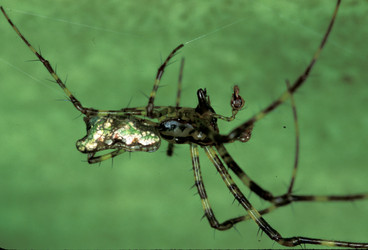

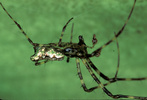

 Go to quick links
Go to quick search
Go to navigation for this section of the ToL site
Go to detailed links for the ToL site
Go to quick links
Go to quick search
Go to navigation for this section of the ToL site
Go to detailed links for the ToL site